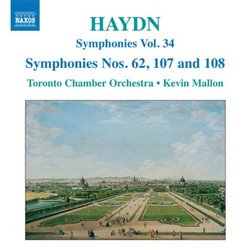| All Artists: Franz Joseph Haydn, Kevin Mallon, Toronto Chamber Orchestra Title: Joseph Haydn: Symphonies, Nos. 62, 107 and 108; Vol. 34 Members Wishing: 0 Total Copies: 0 Label: Naxos Original Release Date: 1/1/2008 Re-Release Date: 10/28/2008 Genre: Classical Styles: Historical Periods, Classical (c.1770-1830), Symphonies Number of Discs: 1 SwapaCD Credits: 1 UPC: 747313213078 |
Search - Franz Joseph Haydn, Kevin Mallon, Toronto Chamber Orchestra :: Joseph Haydn: Symphonies, Nos. 62, 107 and 108; Vol. 34
 | Franz Joseph Haydn, Kevin Mallon, Toronto Chamber Orchestra Joseph Haydn: Symphonies, Nos. 62, 107 and 108; Vol. 34 Genre: Classical |
Larger Image |
CD Details |
CD ReviewsLast Release of Haydn Symphonies on Naxos JohnL | Alexander, NC United States | 11/12/2008 (4 out of 5 stars) "Yes, this is the last installment of Haydn Symphonies released on Naxos, the budget classical CD leader, as I see that Naxos is just releasing the complete set of Haydn Symphonies on 34 CDs, just in time for the 200th anniversary of the great composer's death in 2009. It is commonly accepted that Haydn penned 106 symphonies in total. Then why, you might ask, does this Vol. 34 include Symphonies 107 and 108? Well, number 105 is actually more commonly known as the Sinfonia Concertante for violin, cello, oboe, bassoon & orchestra. Number 106 is only in one part, so it is not a complete symphony. Numbers 107 and 108 (also known as "A" and "B") were actually written early in Haydn's symphony output, somewhere between 1762 and 1765. So, if the Haydn Symphonies were re-numbered entirely chronologically, then these two would be numbered somewhere between 1 and 25. Number 62 was written later, by 1781. This trio of works is nicely recorded here on Naxos by the Toronto Chamber Orchestra under the direction of Kevin Mallon. The tempos are well-chosen, with nice digital sound captured by the Naxos people. As a bonus, the CD also contains two overtures: La vera costanza and Lo speziale, which are multi-movement works similar to a symphony or suite. The only drawback is the harpsichord continuo throughout, which is too prominent, especially in the quieter passages. But this is a matter of personal taste I suppose, as many realists would claim that the harpsichord is part of the original score in each work. All in all, this is a decent disc to wrap up Haydn's great orchestral works on Naxos."
|
